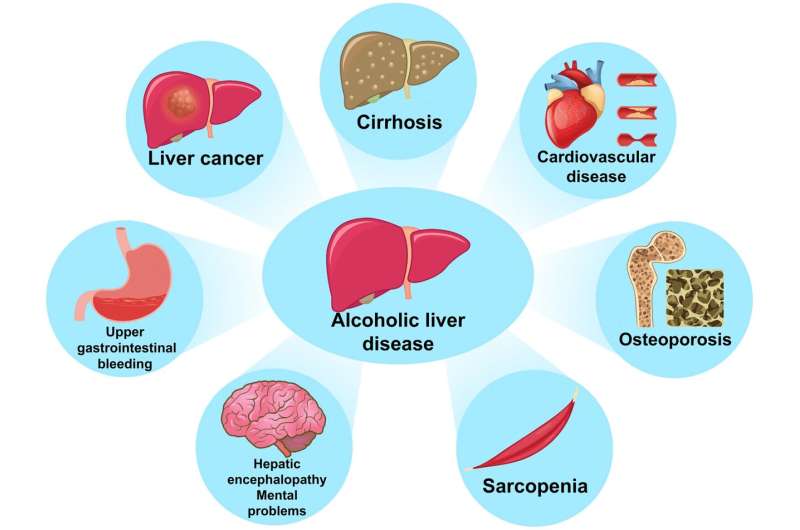This article has been reviewed according to Science X's editorial process and policies. Editors have highlighted the following attributes while ensuring the content's credibility:
fact-checked
proofread
Alcoholic liver disease in China: A disease influenced by complex social factors that should not be neglected

Alcoholic liver disease (ALD) is a major cause of liver-related morbidity and mortality globally. Chronic alcohol consumption, a primary driver of ALD, leads to a spectrum of liver conditions ranging from fatty liver to cirrhosis and hepatocellular carcinoma.
In China, the incidence of ALD has been rising at an alarming rate, reflecting the country's rapid economic growth and changing social norms around alcohol consumption. This paper explores the complex social factors influencing ALD in China, the complications associated with the disease, and the urgent need for improved treatment strategies.
Social context of ALD in China
Alcohol consumption is deeply rooted in Chinese culture, often associated with social and business interactions. Drinking is a common practice in various ceremonies, celebrations, and business negotiations, where refusal to drink can be perceived as disrespectful. This cultural norm fosters environments where excessive drinking is encouraged, contributing to the high prevalence of ALD.
The rise in alcohol consumption among Chinese adolescents is a concerning trend. Studies indicate that a significant percentage of high school and college students engage in drinking, with many reporting alcohol-related problems. The early onset of drinking behaviors in this demographic can lead to long-term health consequences, including an increased risk of developing ALD.
The preference for high-alcohol-content spirits, particularly baijiu, and the widespread availability of unbottled alcohol contribute to the high incidence of ALD in China. These potent beverages are often consumed in large quantities during social gatherings, further exacerbating the risk of liver damage.
Current status of ALD
ALD is a significant global health issue, accounting for a considerable proportion of liver-related deaths and disability-adjusted life years (DALYs). The burden of ALD is increasing worldwide, particularly in regions with high alcohol consumption rates. The World Health Organization reports that alcohol consumption is responsible for a substantial percentage of liver cirrhosis cases globally.
In China, the prevalence of ALD mirrors that of Western countries, with a significant portion of the population engaging in heavy episodic drinking. The disease burden related to alcohol consumption is substantial, contributing to the increasing public health challenges faced by the country. The rapid urbanization and economic growth have led to lifestyle changes that include higher alcohol intake, further fueling the ALD epidemic.
Complications of ALD
Cirrhosis is one of the most severe complications of ALD. Chronic alcohol consumption leads to progressive liver damage, starting with fatty liver, advancing to alcoholic hepatitis, and eventually resulting in cirrhosis. In China, the incidence of ALD-related cirrhosis is increasing, presenting a significant public health challenge. Patients with cirrhosis often suffer from multisystemic complications, including portal hypertension, hepatic encephalopathy, and liver failure.
Patients with ALD are at a heightened risk for upper gastrointestinal bleeding due to the damaging effects of alcohol on the gastric mucosa and the development of portal hypertension. This complication is particularly dangerous as it can lead to significant morbidity and mortality if not managed promptly and effectively.
Treatment challenges and future directions
Despite advancements in understanding the pathogenesis of ALD, effective treatment options remain limited. Current therapeutic approaches focus primarily on managing complications rather than addressing the underlying disease mechanisms. Abstinence from alcohol is the cornerstone of ALD management, but maintaining sobriety is challenging for many patients due to the addictive nature of alcohol.
There is an urgent need for new treatment strategies to combat ALD. Precision medicine, which tailors treatments based on individual genetic, environmental, and lifestyle factors, holds promise in addressing the unique challenges posed by ALD in China. Additionally, public health interventions aimed at reducing alcohol consumption and promoting healthy lifestyles are crucial in mitigating the disease's impact.
ALD in China represents a pressing public health issue influenced by complex social and cultural factors. The increasing prevalence of the disease, coupled with severe complications and a lack of effective treatments, underscores the need for comprehensive strategies to manage and prevent ALD.
Future research should focus on developing targeted therapies and public health policies that address the unique context of alcohol consumption in China. By understanding and addressing the root causes of ALD, it is possible to alleviate the disease burden and improve health outcomes for those affected.
The study is published in the Journal of Clinical and Translational Hepatology.
More information: Xiaofeng Feng et al, Alcoholic Liver Disease in China: A Disease Influenced by Complex Social Factors That Should Not Be Neglected, Journal of Clinical and Translational Hepatology (2024). DOI: 10.14218/JCTH.2024.00034




















